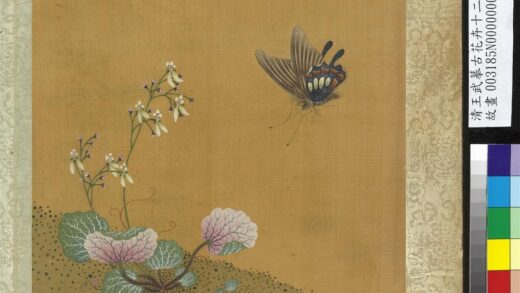【作品基本信息】
| 作者 | 李士达 |
| 品名 | 山林人物图-明人画扇册 |
| 朝代 | 明朝 |
| 文件大小 | 18.04MB |
| 分辨率(DPI) | 300×300 |
| 像素大小 | 2834×2122 |
| 尺寸(CM) | 23.99×17.96 |
| 创作时间 | 明神宗万历四十年(1612) |
| 作品数量 | 1 |
| 作品收藏 | 台北故宫博物院 |
| 图片格式 | 默认提供TIF和JPG两个版本 |
基本数据
| 藏品类型 | 绘画 |
| 品名 |
明人画扇 册 明李士达山林人物 Figures in a Mountain Forest |
| 分类 | 绘画 |
| 作者 | 李士达 |
| 创作时间 | 明神宗万历四十年(1612) |
| 数量 | 一幅 |
典藏尺寸
| 【位置】 | 【尺寸】(公分) |
| 本幅 | 17.2×50.6 |
质地
| 【质地位置】 | 【质地】 |
| 本幅 | 纸 |
题跋数据
| 【题跋类别】 | 【作者】 | 【位置】 | 【款识】 | 【书体】 | 【全文】 |
| 作者款识 | 李士达 | 本幅 | 万历壬子(公元一六一二年)三月。写于石湖村舍。李士达。 | 行书 | |
|
印记: 士达 |
|||||
印记资料
| 【印记类别】 | 【印记】 |
主题
| 【主题类别】 | 【主题(第一层)】 | 【主题(第二层)】 | 【主题说明】 |
| 次要主题 | 山水 | 奇石 | |
| 次要主题 | 人物 | 官员(臣) | |
| 次要主题 | 人物 | 侍从(侍女、童仆) | 童仆 |
| 次要主题 | 花草 | 桃花 | |
| 其他主题 | 树木 | 寒林.枯树 | 枯树 |
| 其他主题 | 器用 | 扇 | |
| 其他主题 | 器用 | 家具(屏风) | 桌、椅 |
| 其他主题 | 器用 | 饮食器 | 灶、盘、碗 |
| 其他主题 | 器用 | 文房用具 | 笔、砚、卷 |
技法
| 【技法】 | 【技法细目】 |
| 工笔 | |
| 写意 | |
| 皴法 | |
| 苔点 | |
| 人物衣纹描法(匀称线条) |
参考数据
| 【类别】 | 【参考数据】 |
| 收藏着录 | 石渠宝笈三编(干清宫),第二册,页610-611 |
| 收藏着录 | 故宫书画录(卷八),第四册,页164 |
| 内容简介(中文) |
李士达(生卒年不详),江苏吴县人。号仰槐。万历二年(公元一五七四年)进士,后隐居不仕。画人物、山水名世。 春夜桃花林下,高士雅集,或张素赋诗,或闲倚啜饮,旁有童子执壶燃薪,各具情态。似写李白「春夜宴桃李园序」一文的情景,李士达曾论画有「五美」云:「苍、逸、奇、远、韵。」此画笔墨苍深,人物造型有古拙之趣,足以印证他的画论。款万历壬子为公元一六一二年。 本幅为「明人画扇」册第十开。 |
| 内容简介(英文) |
Figures in Forested Mountains Li Shih-ta (fl. late 16th-early 17th century) Ming Dynasty Li Shih-ta (sobriquet Yang-kuai) was a native of Wu-hsien, Kiangsu. After he received his chin-shih civil service examination degree in 1574, he became a hermit and did not take office. He was famous for his paintings of figures and landscapes. In this painting, a literary gathering of scholars is taking place under a canopy of peach blossoms on a spring evening. Some of them unroll sheets of paper to compose poetry, and others relax with refreshments. Off to the side are boy attendants warming a container over kindling. Everything in the painting has been rendered full of sentiment, as if the painting represents a scene described in Li Po’s (701-762) “Preface to ‘A Banquet in the Peach-Plum Garden on a Spring Evening.’ ” Li Shih-ta once discussed painting as having the “Five Beauties” of “Strength, Untrammeledness, Eccentricity, Distance, and Vibrancy.” The ink and brushwork in this painting are rich and deep, and the depiction of the figures has a sense of archaic clumsiness; they thus all sufficiently prove his theory of painting. The inscription on this work is dated to 1612. |
| 收藏着录 | 故宫书画图录,第三十册,页146-153 |
【作品展示】

明人画扇册明李士达山林人物


_0924162954_1.jpg)

